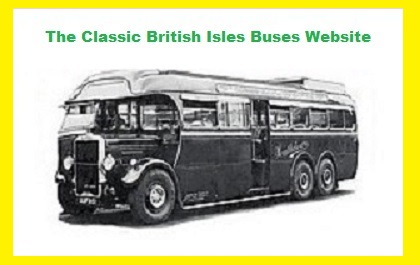

The Classic British Isles Buses Website
Transport in Sri Lanka in 2003 (by Dick Gilbert)
Last updated 29 August 2024
Email Events diary Past events list Classified adverts Classic U.K. Buses Classic Irish Buses Classic Manx Buses
| Transport in 2003 | Transport in 2015 |
Acknowledgements; My thanks to Maurice Bateman, Vic Brumby, Mark Harrington, Simon Lang, Bob Martin, Peter Relf, Roger Thiedeman, and Dale Tringham for their help in supplying additional information, and sorting out fact from fiction (hopefully!) in the report below.
Since the war, more than 1500 old London Transport buses have been exported to Sri Lanka (formerly Ceylon), and that figure may yet rise. As far as I have discovered, single-deck exports included 50 T-class Regals, 100 TD Leyland Tigers, and ten of the total of fifteen RFW Regal IV coaches built. 30 C class Leyland Cubs (and even eight CRs) also went there. Among the double deckers were 89 D class utility Daimlers and seventeen G class utility Guy Arabs.
** See an update on this information at the foot of this page **!
In the mid 1960s a huge transfer of double deckers took place. I am told that 729 RTLs, 280 RTWs and 266 RTs were exported there. Finally, 41 Routemasters were shipped out in the late 1980s.
There must surely be some surviving evidence of this massive fleet on the island today, and when I took a holiday there in October 2003 I decided to keep my eyes peeled for any vehicles still running, or maybe retired examples around the country.
The first of these buses arrived in 1952, and the entire bus operation on the island came under the wing of the Ceylon Transport Board (CTB) from 1st January 1958, a government agency set up to nationalise all services. Subsequently this was transferred to a worker-controlled operation (known locally as peopolised!) and was renamed the Central Transport Board (still CTB). The service was split into regional operations centered on the main towns, and private operators were also then permitted to set up business.
At the time of my visit there were four main liveries which indicated the nature of the operation. Older CTB vehicles wore a combination of bare-metal and red (usually red front and back), but these buses tend to be pretty ancient and often are working out their last years until they totally fall apart.

A Tatty TATA in the old CTB red/silver livery running a local service near Galle.
The more recent CTB livery is all-over yellow, and all newer CTB buses are painted in this way, often bearing the name of the regional bus service to which they are attached. Longer distance and express CTB services have variations of a livery of off-white with two horizontal stripes, usually one red and one blue.
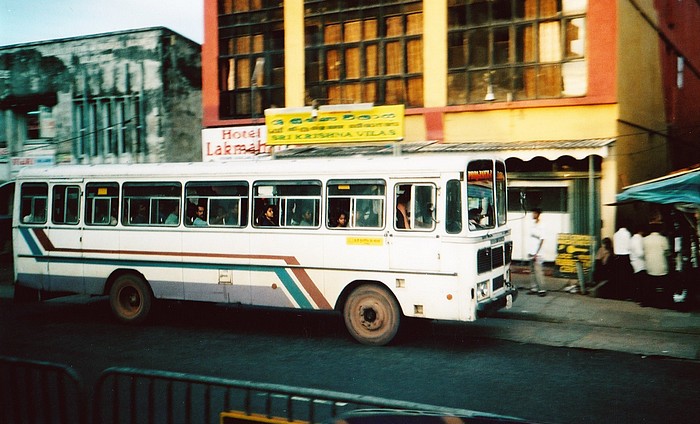
An Ashok Leyland in the CTB striped livery grinds out of Colombo on a regional service.
Finally there is everything else, which means every colour scheme imaginable, and which indicates a private operator - of which there are literally thousands, many with only one bus in the fleet.

A Saduni Travels TATA works a local service in Colombo.
However, as with everything else in Sri Lanka, there are no hard and fast rules. It didn't take long for private operators to realize that, if they painted their bus to look like someone else's, they could steal unsuspecting passengers from the competition and then charge them slightly more than the going rate (once on board there wasn't much the passenger could do about it!). So some liveries may be deliberately misleading.
Public transport in Sri Lanka today is hugely varied. At the lower end of the scale, a tractor and trailer is quite adequate, and various bits of agricultural machinery can be seen in common use as a local (if slow) bus transport. But by far the most common medium is the tricycle motorized rickshaw, also known as an autorickshaw, trishaw or - more commonly in India and Sri Lanka - the tuk-tuk. The usual model is the Bajaj RE, a 145cc rear-engine 2-stroke, with four forward gears and one reverse. They are made in India in association with Vespa, and seat three (or four at a push) in the back, with the driver in the front controlling the machine with scooter-type handlebars. They have a large front windscreen and a removable canvas roof, which is always kept up, as Sri Lankan passengers will inevitably be either avoiding the hot sun or the rain.
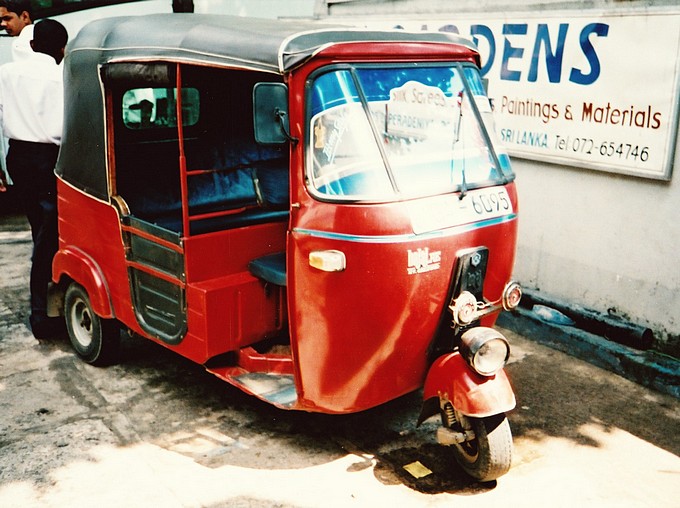
Tuk tuks are absolutely everywhere. This is the Bajaj RE.
These Tuk-Tuk taxis are incredibly daring, cheeky and nimble in the traffic, and it is said that if you stand with your feet too far apart, one will zoom between your legs. If you need a ride, don't bother to find one, they'll find you! They are by far the most common form of transport, and you would be hard pressed to stand in the street in any town or village without being able to see at least half a dozen at any one time, and often twenty or more, in all the colours of the rainbow. Other models can occasionally be seen, including the splendidly-named Greaves Garuda, and the Piaggio Ape.
The next size up is what I would call the 15 cwt minibus - i.e. the size of a standard old VW van. These, and the next size up again (the 25-35 seat range, perhaps the modern equivalent of the Bedford OB) tend to standardize on vehicles of Japanese manufacture. Import tax on second-hand vehicles is less than on new ones, so there is a huge market for slightly-used Japanese buses, van and trucks which are imported in thousands, often still wearing Japanese writing on the side from their previous owners. They include Toyota, Mitsubishi (to my amusement, always called Mister Bushy in the Caribbean), Nissan, Mazda and Hino, but the chassis of choice seems to be Isuzu, by far the most common.
Finally come the full-sized buses, now exclusively single deck. The two main manufacturers are Tata (Indian-built Mercedes), and Ashok Leyland - or the Sri Lankan licence-built version, the Lanka Ashok Leyland, made in a factory just outside the capital, Colombo. The bodies are frequently Duple Metsec products either assembled by the local Latec plant on the island, or by their subsidiary WESCO (Werahera Engineering Services Co. Ltd.). Among the private operators can be seen a wide variety of buses, with Isuzu again being a front-runner, but I did notice some more unusual makes, including Hindustan Motors from India, and Great Wall Motors from China.

A Tata in the CTB yellow livery hurries along the coast near Hambantota.
I referred to seating capacities above but, as always in Sri Lanka, standard rules do not apply. I saw about 35 standing passengers in the back of a 15 cwt Toyota pick-up, so you can imagine that figures for larger buses can become quite staggering. Full size buses (i.e. around 30 feet long) normally have about 12 rows of seats, which would suggest a capacity of perhaps 50 passengers, but at peak periods you can probably double that. All double seats take three people, every square inch of floor space is taken up with standing passengers, and then there are those who hang on to the side - if you can get one foot on the entry step and one hand on a grab rail, then you're on board!
How they manage to collect fares under these conditions is beyond me, but it clearly shows the reason for the inevitable dual-entrance bodywork, as anyone squashed into the far corners of the bus must have great difficulty getting off, especially with the large amounts of baggage and goods that many passengers carry with them. It makes the London Underground rush hour seem like luxury travel.
So there's an overview of the current public transport scene in Sri Lanka, but what about those 1500 old London buses? Ah yes, I hadn't forgotten.
I guessed that the early fleets of single deckers (T, TD, C and RFW) had long been retired, and I had no expectation of seeing a trace of any of them, although I understand that two of the TDs, converted to lorries, were still active in 1994. Certainly the utility double deckers (Daimlers and Guys) would be gone, but maybe there would be evidence of the RT, RTL, RTW or RM buses that had followed later. However, those more recent exports had, I was led to believe, all gone in one of three ways.
Quite a few had, on retirement from passenger service, been converted to flatbed lorries. These were fitted with new (and quite large) cabs, and were used for the transportation of sea containers to and from the port of Colombo. Many others had been given replacement single-deck bodywork, and continued in service in this guise. Finally the majority of the remainder had been scrapped and/or broken up for spare parts. I had a report of one chassis actually being made into a fence! Incidentally, the breaking of a vehicle for parts in Sri Lanka is a very thorough business - nothing is wasted at all - and a vehicle that has been scrapped is likely to leave no trace whatever.
So identifying these as we drove around in our luxury Volvo B7B coach was clearly going to be difficult, and I therefore made a list of their Sri Lankan registration numbers (when known) before I went, as I assumed that the converted vehicles kept their old numbers. Spotting a likely licence plate might be easier than pinpointing a heavily disguised old bus. But that turned out to be untrue, as nearly all the conversions received new numbers, so I was actually looking for something that wasn't there ! At this point, a quick appraisal of the Sri Lankan registration system might not go amiss.

This old Wolseley was kept as an exhibit at the Gangarama Buddhist temple in Colombo. It illustrates the old licence plate system. Vic Brumby kindly researched it a little further, and advises me that it is a Wolseley New Fourteen dating from 1935, and is believed to be the 104th built, although the engine may not be original. Thanks also to the Wolseley Register for confirming that it is a 1935 Wolseley W14, chassis number NF604/181.
The original system (in use from 1928 to 1956) strongly resembled the UK system of the period in style and size, with a combination of letters and numbers, in white on a black background. The letter X (and later Y and Z) were used for petrol vehicles, and IC for diesel. Later, 2-letter prefixes were used, starting with C, then E, then Y - you can see where this is going... CEYLON ! However, independence seems to have inspired the authorities to come up with a more complicated new scheme, again comprising two parts, a number (initially two digits, but later three) indicating the class of vehicle, and a further individual number (four digits) for the specific car. These two numbers were separated by a symbol in local script which represented Sri (the approximate equivalent in Sri Lanka of the Great in Great Britain). So the result was, for example 20 Sri 1234. Later the Sri symbol was replaced with a dash (20-1234).

>Also at the Buddhist temple was this beautiful old Riley One and a Half, showing the other layout of the old registration system.
The prefix numbers worked on a coded system which nobody locally was able to explain to me satisfactorily, but the most likely explanation I received was: 1 to 19 for private cars, 20 to 29 for petrol buses and trucks, 30 to 39 for diesel buses and trucks, 50 to 59 for diesel vans and minibuses, 60 to 69 for diesel buses and trucks, 100 and above for motorcycles. Presumably as a result of the above numbers running out, 200 and above was also used for petrol vans, minibuses (and the ubiquitous tuk-tuk tricycle rickshaws), and 300 and upwards for diesel vans and minibuses.
Again the numbers were white on a black background, but slightly smaller than British plates. However, some were red on a white background, and at first I was told this applied to buses only. But this was clearly not correct, as some trucks and tuk-tuks were also red, so a later explanation that it meant for hire is maybe nearer the truth.

A fine looking 1950s Austin Cambridge van opposite the marketplace in Nuwara Eliya, 6200 feet up in the central highlands.
About 2001 it was decided to introduce a more simplified system, and reflective number plates are now in use, closely resembling the current British system once more, with white plates at the front and yellow at the rear, all letters being in black. The new arrangement consists of two letters used sequentially (e.g. GB follows GA etc.) and four digits, separated by a dash (GA-1234). However, the alphabetical sequence did not start with AA but began with G (GA, GB, GC etc.). When I asked why this should be, it came as quite a surprise to locals, who had never really thought about it. No satisfactory explanation was offered, but anyway the sequence had (at the time of my visit) reached HN. The letters I, O, Q and Z are all used.
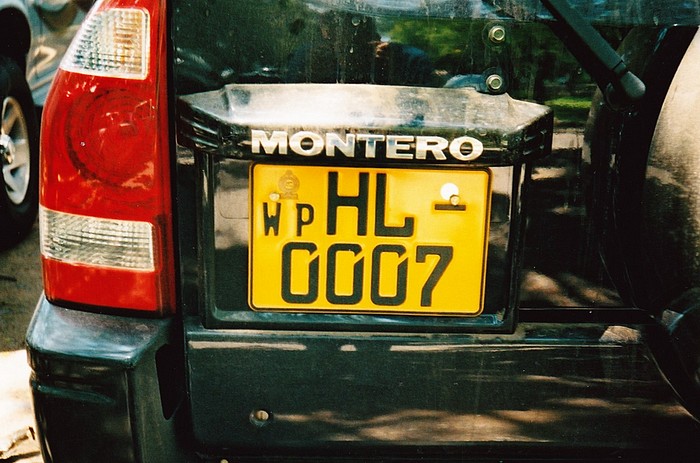
The new Sri Lankan registration plate (rear). In addition, two more smaller letters are on the plate which indicate the Province of issue; CP = Central Province, EP = Eastern Province, NC = North Central, NE = North Eastern, NW = North Western, SG = Sabaragamuwa, SP = Southern, WP = Western, UP = Uva Province. Finally a small circular hologram, about the size of a penny coin, is attached over the dash between the numbers, presumably as a security feature.
All of the styles mentioned above can currently be seen on Sri Lankan roads, so the whole system is a complete muddle, and this is not helped by the occasional appearance of white-on-red plates starting with the letters K (K-1234), or sometimes C or WPC (these may be trade plates), and I also saw one which was black on blue. I was also told that the police had no numbers at all - which turned out to be complete rubbish, as all the emergency vehicles I saw had the same numbers as everyone else (apart from one Fire Service vehicle in Kandy with no plates at all).
So, armed with this information, and knowing that all the RT-type double deckers had numbers in the 20-1234 sequence and the RMs were all 60-66xx, I started glancing at any older vehicle that passed to see what would become apparent. I soon got the hang of what machines to ignore. There were a lot of other interesting sights out of the coach window as we travelled, so I wasn't going to spend my whole time reading registration numbers!
I struck gold on day one. RM 1121 (60-6622) in good condition, was sitting in a yard by the road in Colombo wearing a bright red livery advertising Kentucky Fried Chicken ! Apparently it was fitted out as a kitchen, and would park out on Galle Face Green daily as a mobile fast food bar - chicken on wheels, it claimed. (Andrew Webb informs me that it was still in use in early 2006, and he had a distant glimpse of another near Mount Lavinia.)

RM 1121 resting between its fried chicken duties in Colombo.
In the town of Kandy I had been told that there was one (maybe two, but probably just one) Routemaster still operating a shuttle to and from the Botanical Gardens. On the second day that we were in the town, I emerged from a handicraft shop to be told by our coach driver that I had just missed it ! He said not to worry, as it would soon come back again, but it never did. (Andrew Webb advises me that there was no sign of it in 2006.)
Roger Smith wrote; "I was on holiday in Sri Lanka in November 2007 - visiting the Kandy Botanical Gardens on a delightful day I was sitting with some friends in a restaurant opposite the gardens when the highly distinctive sound of a Routemaster rushed by. I caught a glimpse of it as it rumbled along at high speed, too quickly for me to grab my camera. About half an hour later it thundered by in the reverse direction, again too fast for me to get my camera to hand. It was heavily dented along the roofline and of course the windows have been changed to the tropical style some years ago. Wheel trim gone of course but, for all that, a Routemaster nonetheless." Thanks for that Roger. It seems that the Kandy Routemaster managed to evade all photographers - until now.....
Here's the proof! Robin Wiles wrote in March 2010 "I can confirm that at least one Routemaster is still in operation in Kandy. It was spotted making a quick getaway from the Peradeniya Gardens just outside Kandy at the end of January 2010. My wife spotted the bus while we were waiting for our tuktuk driver outside the gardens. It was a real struggle to get a shot before it sped off, but here it is..."

The registration 60-6615 proves that it was RM2158. Originally CUV 158C it was new in 1965 (during which year it went on a tour to Italy), was painted in Shillibeer livery 1979-80, withdrawn in 1986 and exported to Sri Lanka in 1988. It was noted working in Kandy as a service bus (KS79) in 1996, and is clearly still there. Is this the last ex London Transport halfcab bus still in normal passenger service in Sri Lanka?

Here's another picture of it. Robin points out that you see the tropical windows (reportedly fitted by L. T. before export from the U. K.) and also the dented roof mentioned by Roger Smith. Robin says "the poster on the back window supported the presidential election which was taking place during our visit". Many thanks to Robin for the interesting pictures.
Dave Spencer called me in October 2014 to say that he'd just got back from Sri Lanka and the RM in Kandy was still up and running. He also spotted an Atlantean (on route 100) and a Metrobus (on route 130) on the road from Galle to Colombo, so future visitors may like to look out for those. He took loads of great video while he was there and you can find it here. Thanks Dave.
And the story continues, because here it is again!

Wouter van der Brugghen took this picture in Kandy in the first week of April 2018, and it undoubtedly shows RM2158 passing the Cargills Food City store in Sri Dalada Veediya. He also recorded some great video which you can see here. Thanks Wouter. I'm amazed.
Stuart Hicks emailed me from Kandy in November 2019 to say that the bus was STILL working!
And that was that. Twelve days and only one sighting, for all my efforts. I was told that the container lorries had certainly all now gone, probably all the single decker conversions had also gone, and the total number of double deckers in the country was probably less than five. Rumours of RTs behind the bus depot at Galle proved unfounded, and a similar story for Trincomalee remains unproven as we didn't go there - it's still apparently dangerous country up in the north. There were said to be a few wrecks lying around in fields, but I saw none and didn't have the opportunity to search.
So I have virtually nothing to show for all the research and preparation, although I have to say that my Sri Lankan holiday was an absolute delight. I thoroughly recommend that you go yourself, and see if you can find the evidence that eluded me. Or just go for a great holiday, which is a far better idea.
Peter Robinson kindly emailed in June 2008 as follows; "I read the above item with great interest as I have been on holiday there on four occasions because my wife likes elephants and I go for the railways. When we went in 1994, three Routemasters were still operating on a Ratmalana - Pettah service. They probably carried a couple of hundred passengers at least during rush hour!"
"This year, I didn't expect to see a Routemaster. However on Monday 17th March we had been to Pinnawella elephant orphanage and I was driving back to our hotel in Kandy, when, near Kadugawanna, what should appear round a bend travelling in the opposite direction but a Routemaster apparently operating a local bus service. It definitely wasn't the KFC one as it appeared to be in original condition and was carrying a destination board (in Sinhala unfortunately) and passengers and was still painted in something closely approximating its original livery. Sorry, I haven't got any more information as I do not know a lot about buses but it would appear that there is still a Routemaster presence on the island." Thank you for the update Peter.
A little diversion. There were two of these things (wheel-less) propped up beside the road in Colombo. They clearly have some railway or tram background, but they looked a bit small to perform a useful function for the Colombo crowds. This one had a badge on the side reading (I think) CSR, and a scrawled inscription LOT 24 ! Any suggestions anyone?
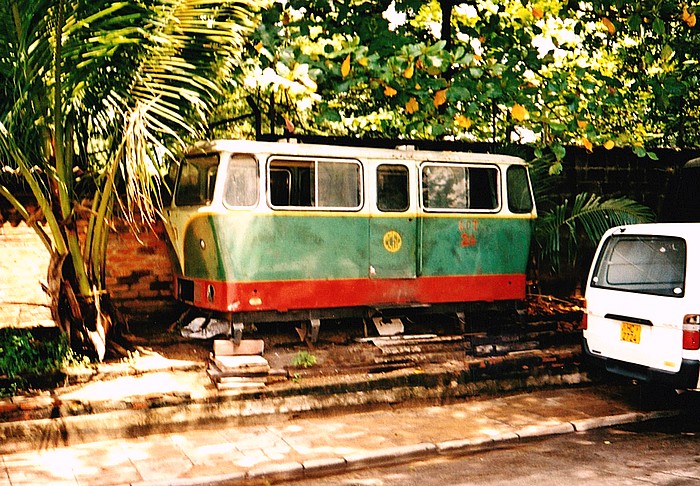
In response the above appeal for info, Peter Relf says "Re: the railway thing, CSR will probably be CGR - Ceylon Government Railways. I would imagine that they were probably inspection vehicles of some kind.", and Mark Harrington wrote "I reckon these are the equivalent of the British Wickham of Ware railway personnel carriers once a common sight on colonial railways. There was a railway system on Sri Lanka until the 60s(?) so these may well be a relic."
And Roger Thiedeman says "The vehicle pictured is one of several motor trolleys/inspection cars used by the Ceylon Government Railway (CGR). One batch of six, introduced circa 1981, had the serial numbers 815 to 820, of which nos. 815 to 817 were locally built by the CGR. The others were built by Wickham (Type 42/S ?). The one in your website doesn't resemble the photo of locally-built no. 815, as depicted in Dr. David Hyatt's excellent book railways of Sri Lanka. Therefore, it could be one of the Wickhams."

In November 2019 Stuart Hicks spotted this in a siding at Kandy station. The number 815 reveals it to be the first of the 1980s batch mentioned above by Roger Thiedeman and built locally. It's not quite the same as the one I saw in Colombo which, I guess this proves, must be one of the Wickhams. Many thanks to Stuart for the photo.
Thanks to everyone for their input. Well, there is indeed still an extensive railway system in Sri Lanka, covering most of the island apart from the hill country. It's mostly single track, but double on some main lines, and is very busy. The gauge is - to English eyes - rather wide in appearance at 5ft 6ins, and most of the rolling stock looks somewhat dated, with 2nd and 3rd classes only, as far as I could see - neither of which are exactly luxurious!


On the left is an interior shot of a typical third-class carriage. The outside shot on the right shows the inscription for clergy over the window, although I doubt if that works in the rush hour. The open window is the key to getting a seat. As the train pulls into the station, and while passengers are getting off, you throw your bag through the window on to the seat within, and this reserves your space for when you finally get on board.
The locomotives on the route we used (Kandy to Nawalapitiya) were diesel-hydraulic, made by Henschel in Germany, but I did see one ancient steam tender engine hauling a mixed-traffic train into Colombo on the first day - sadly too far away to photograph. More modern DMUs work the main line down the coast from Colombo to Galle and they are very busy at peak times - about one every five minutes in each direction in the rush hour. I saw some blue and white class S9 units on that route, imported new from China in 2000. These are of particular value because they can convert to overhead power collection, as electrification is apparently planned for the future (that sounds pretty frightening in view of the fact that the local population swarms all over everything the railway system uses!).

A general view of Platform 2 at Kandy.
The population seem to use the railway tracks as a pathway - the quickest route between two points I suppose - and the trains are constantly hooting to clear them out of the way. We travelled for about an hour and a half out of Kandy, heading south. The timekeeping was very fluid (the first half hour delay doesn't count!). Our Volvo coach took the road route, and we saw it several times from the train, we raced the coach all the way to Nawalapitiya, and beat it by about 5 minutes!

A Henschel diesel-hydraulic loco, no. 673, has just arrived at Kandy with typical Sri Lankan rolling stock. These were new in 1969 as Class W1 locos, but were later refurbished, re-engined and upgraded to become Class W3.
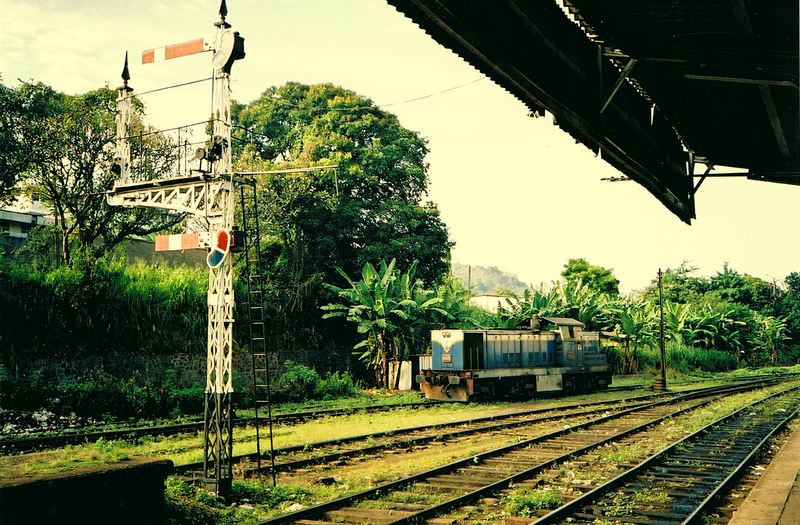
Another Class W3 Henschel waits in the yard for its turn to pull a train north out of Kandy (Kandy is a terminus on all but one of its platforms). The new power plants in these refurbished locomotives are 1000 hp Caterpillar V12 monsters.
Colour light signals were used around Colombo, but semaphore signals seem to be in use everywhere else. The track buckles and bends a bit as the trains pass by, and it can be a bit of a roller-coaster at times, but the speeds are not that great and you don't feel unsafe. It's the people on the line that should feel unsafe!
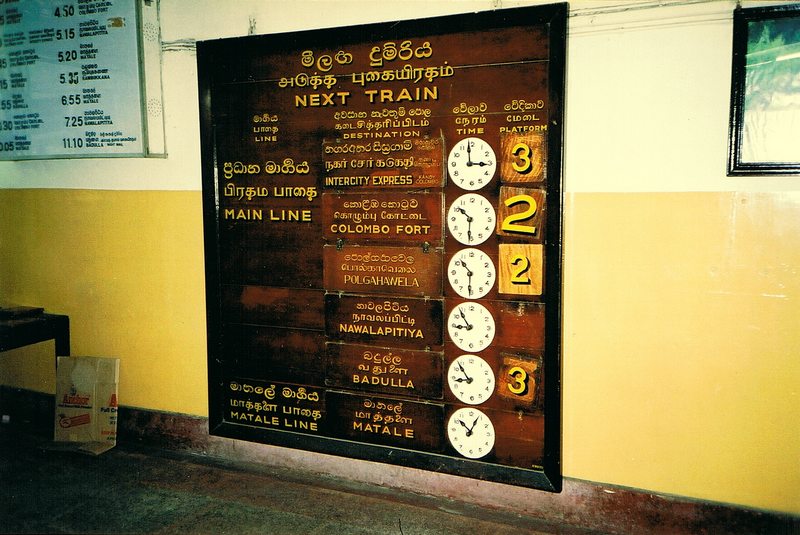
The destination and timetable board at Kandy - times are approximate!
Well, that's my story, but if you would like to follow up this topic, here are some fine Sri Lankan Transport websites:
BUSES
Film of RTWs working in Sri Lanka
http://www.bokhans.com/bussar.html
http://www.bokhans.com/trollybus.html
RAILWAYS
http://www.infolanka.com/org/mrail/slrails.html
UPDATE FROM 1955!
Regular correspondent to this website, Vic Brumby, kindly sent me a copy of an article in Buses Illustrated for October 1955, in which a Mr. N. Blow had written to say what British buses he had seen in Ceylon in January of that year. He had even consulted the Chief Engineer of South Western Omnibus Co. (Ceylon), Colombo, to try to get the facts straight! Here is a brief outline of what he recorded:
DAIMLERS - ex D Class, 85 in number, of which about a dozen were converted to single deckers. "Apparently the Daimlers are very popular with the drivers and are easy to handle. The population was at first shy of riding on the top deck, they thought the bus would tip over".
GUYS - 29 in number, of which 12 were from London (G class). The remainder came from Scotland although he was unable to find out where.
LEYLAND CUBS - 30 examples. As 20-seaters they were found too small, and so were lengthened to take 41 passengers. The door had been moved as far forward as it would go to allow more seating space.
LEYLAND CUB REAR-ENGINED - Eight CR class buses. Having the engine at the rear presented some difficulty in cooling, and to overcome this a vent had been inserted just above the front number plate, and cool air was carried to the back under a raised channel along the centre gangway.
OTHERS - "The rest of the fleet consists of a number of post-war Leyland PD1s similar to the London STD class, and odd Chevrolets, Dodges and a Commer."
MORE FROM VIC BRUMBY
In July 2009 Vic Brumby sent me this fantastic picture that he took in Ceylon while visiting in 1968.

It shows one of the London Transport TD class Leyland PS1 Tigers after conversion to a lorry, which is what eventually became of a great number of the imported buses. Many were fitted with flatbeds to carry containers from the port in Colombo. There would appear to be a substantial load on the back of this one, and things haven't changed much in Sri Lanka today! I can't tell which of the TDs this is, and I don't have a record of 22-Sri-6403 (maybe somebody can assist?) but it would be one of the second batch (TD32 to TD131) originally with Mann Egerton bodies. Thanks very much Vic - a wonderful picture.
(Maurice Bateman has subsequently emailed me to confirm that it is the former TD93 (c/n 483967), new in April 1949, withdrawn from London Transport service in January 1960, shipped to Ceylon in April 1960, withdrawn by CTB in April 1965, and seen here three years later. My thanks to Maurice for the identity.)
PHOTOS OF OLDIES FROM SRI LANKA
In February 2004 I received these amazing pictures in the post from Vinodh Wickremeratne of Boralesgamuwa, Sri Lanka. I'm not quite sure why it's taken me so long to post them on the website, and unfortunately I've lost contact with Vinodh in the intervening years, but anyway here they are. I believe all the pictures were taken in 2003 although I don't know the locations.

I think the flatbed truck above is a conversion of a London Transport TD class Leyland PS1 Tiger, probably from the second batch which originally had Mann Egerton bodies and were exported to Ceylon in 1959-60. It bears the registration 22-Sri-2698 and the location seems to be a wood yard. Vinodh wrote on the back of the photo old fella!.

In the middle of the row above is a truck registered 28-Sri-1233 and I suspect it's a converted London Transport RTL. Can anyone confirm it? Vinodh's note on the back says center is adaptation.
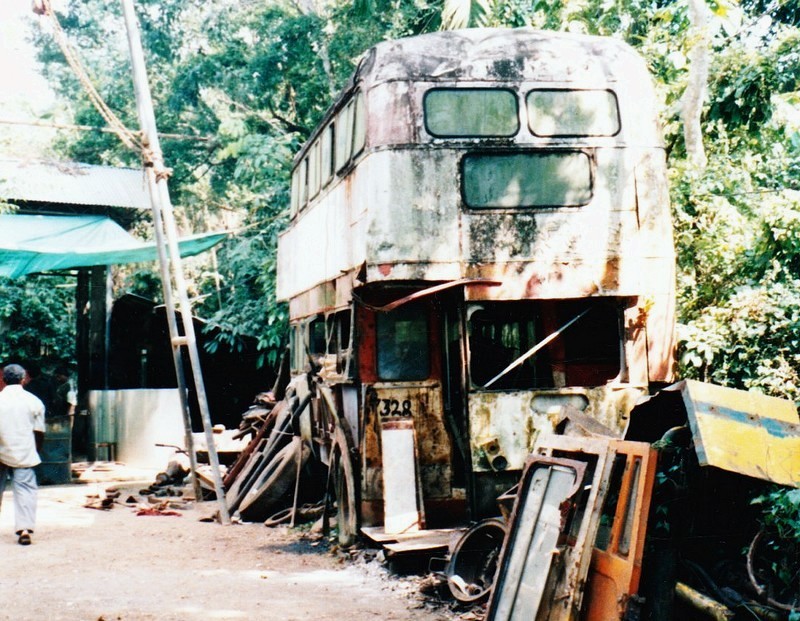
Now here's a mystery. This bus carried the registration IC463 (IC, you will recall, signifies a diesel) and the photo was taken on 19 December 2003. But where did this double decker originate from?
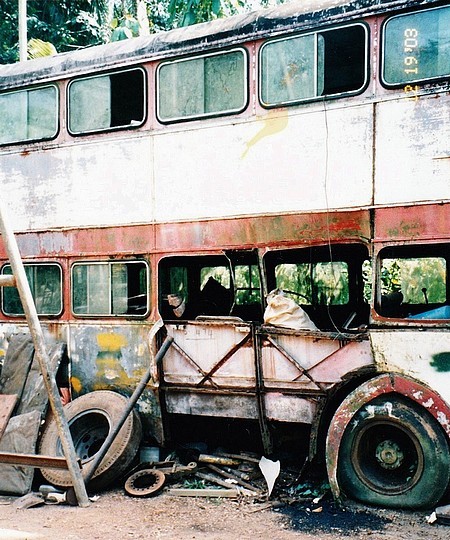
Even though it has been fitted at some time with tropical windows, a side view of the same bus confirms this is not a London Bus.
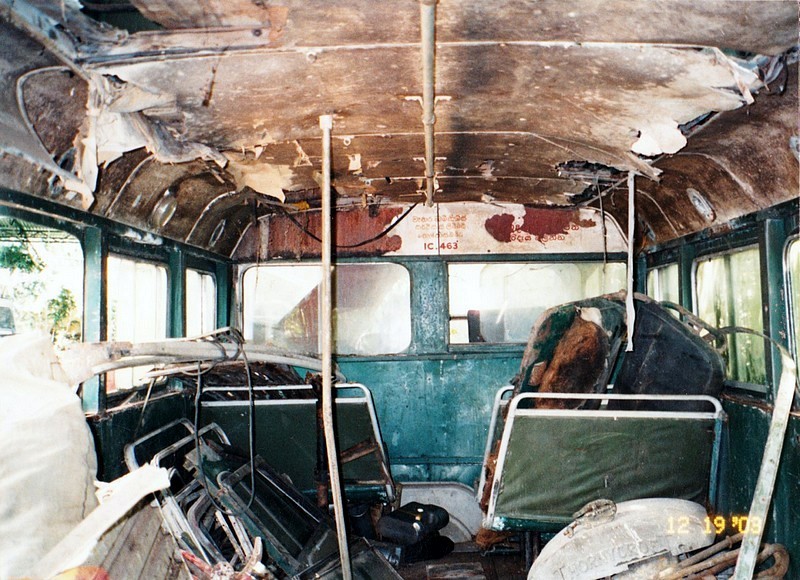
The interior shows that it probably hasn't carried a passenger for several years, but the number IC 463 on the front bulkhead is clear enough. Can anyone say where this bus came from? Meanwhile my sincere thanks to Vinodh, and I apologise for the time it's taken me to set these up.
A response from Simon Lang in November 2023 has provided the answer. Firstly the reg number is pre-1956, so it's not a used import after all. In fact it was one of eight Leyland bodied Leyland PD2s bought new by the South Western Omnibus Company in Colombo in 1947 and 1949 (four in each year) along with ten Guy Arabs bodied by Park Royal and Northern Coachbuilders. As the 2003 photo shows, IC 463 has clearly been heavily altered over the years, including sliding side windows, London RT style upper deck front, and that very non-Leyland rear dome and window. South Western bought eleven Albion Nimbuses (Nimbi??) in March 1956 and in 1958 the company (and many others) were amalgamated into the Ceylon Transport Board. Thank you Simon for clearing that mystery up.
FINALLY SOME ANCIENT PICTURES
There are several interesting pictures on the internet of ex London buses operating in Sri Lanka in the 1980s, and here are links to some of them:
Two RTLs operating in Colombo.
A derelict RTL chassis in a side street.
RTL 448 converted to a single decker.
Email Events diary Past events list Classified adverts Classic U.K. Buses Classic Irish Buses Classic Manx Buses